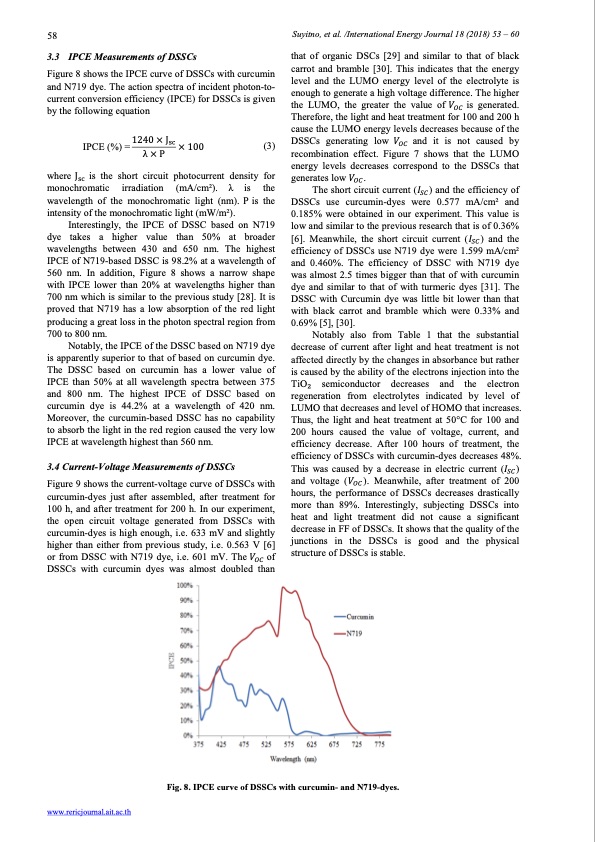
PDF Publication Title:
Text from PDF Page: 006
58 Suyitno, et al. /International Energy Journal 18 (2018) 53 – 60 3.3 IPCE Measurements of DSSCs that of organic DSCs [29] and similar to that of black carrot and bramble [30]. This indicates that the energy Figure 8 shows the IPCE curve of DSSCs with curcumin and N719 dye. The action spectra of incident photon-to- current conversion efficiency (IPCE) for DSSCs is given by the following equation level and the LUMO energy level of the electrolyte is IPCE (%) =1240 × Jsc × 100 (3) λ×P Therefore, the light and heat treatment for 100 and 200 h This was caused by a decrease in electric current (𝐼 ) 𝑆𝐶 or from DSSC with N719 dye, i.e. 601 mV. The 𝑉 of 𝑂𝐶 curcumin-dyes is high enough, i.e. 633 mV and slightly and voltage (𝑉𝑂𝐶). Meanwhile, after treatment of 200 hours, the performance of DSSCs decreases drastically more than 89%. Interestingly, subjecting DSSCs into heat and light treatment did not cause a significant decrease in FF of DSSCs. It shows that the quality of the junctions in the DSSCs is good and the physical structure of DSSCs is stable. higher than either from previous study, i.e. 0.563 V [6] DSSCs with curcumin dyes was almost doubled than the LUMO, the greater the value of 𝑉 is generated. enough to generate a high voltage difference. The higher DSSCs generating low 𝑉 and it is not caused by cause the LUMO energy levels decreases because of the low and similar to the previous research that is of 0.36% affected directly by the changes in absorbance but rather TiO2 semiconductor decreases and the electron is caused by the ability of the electrons injection into the regeneration from electrolytes indicated by level of LUMO that decreases and level of HOMO that increases. Thus, the light and heat treatment at 50°C for 100 and 200 hours caused the value of voltage, current, and efficiency decrease. After 100 hours of treatment, the efficiency of DSSCs with curcumin-dyes decreases 48%. 𝑂𝐶 where Jsc is the short circuit photocurrent density for monochromatic irradiation (mA/cm2). λ is the wavelength of the monochromatic light (nm). P is the intensity of the monochromatic light (mW/m2). recombination effect. Figure 7 shows that the LUMO Interestingly, the IPCE of DSSC based on N719 dye takes a higher value than 50% at broader wavelengths between 430 and 650 nm. The highest IPCE of N719-based DSSC is 98.2% at a wavelength of 560 nm. In addition, Figure 8 shows a narrow shape with IPCE lower than 20% at wavelengths higher than 700 nm which is similar to the previous study [28]. It is proved that N719 has a low absorption of the red light producing a great loss in the photon spectral region from 700 to 800 nm. Notably, the IPCE of the DSSC based on N719 dye is apparently superior to that of based on curcumin dye. The DSSC based on curcumin has a lower value of IPCE than 50% at all wavelength spectra between 375 and 800 nm. The highest IPCE of DSSC based on curcumin dye is 44.2% at a wavelength of 420 nm. Moreover, the curcumin-based DSSC has no capability to absorb the light in the red region caused the very low IPCE at wavelength highest than 560 nm. 3.4 Current-Voltage Measurements of DSSCs Figure 9 shows the current-voltage curve of DSSCs with curcumin-dyes just after assembled, after treatment for 100 h, and after treatment for 200 h. In our experiment, the open circuit voltage generated from DSSCs with [6]. Meanwhile, the short circuit current (𝐼 ) and the 𝑆𝐶 efficiency of DSSCs use N719 dye were 1.599 mA/cm2 and 0.460%. The efficiency of DSSC with N719 dye was almost 2.5 times bigger than that of with curcumin dye and similar to that of with turmeric dyes [31]. The DSSC with Curcumin dye was little bit lower than that with black carrot and bramble which were 0.33% and 0.69% [5], [30]. Notably also from Table 1 that the substantial decrease of current after light and heat treatment is not generates low 𝑉 . 𝑂𝐶 𝑂𝐶 energy levels decreases correspond to the DSSCs that The short circuit current (𝐼𝑆𝐶) and the efficiency of DSSCs use curcumin-dyes were 0.577 mA/cm2 and 0.185% were obtained in our experiment. This value is www.rericjournal.ait.ac.th Fig. 8. IPCE curve of DSSCs with curcumin- and N719-dyes.PDF Image | Curcumin-Dye-Sensitized Solar Cells

PDF Search Title:
Curcumin-Dye-Sensitized Solar CellsOriginal File Name Searched:
10988664.pdfDIY PDF Search: Google It | Yahoo | Bing
CO2 Organic Rankine Cycle Experimenter Platform The supercritical CO2 phase change system is both a heat pump and organic rankine cycle which can be used for those purposes and as a supercritical extractor for advanced subcritical and supercritical extraction technology. Uses include producing nanoparticles, precious metal CO2 extraction, lithium battery recycling, and other applications... More Info
Heat Pumps CO2 ORC Heat Pump System Platform More Info
| CONTACT TEL: 608-238-6001 Email: greg@infinityturbine.com | RSS | AMP |